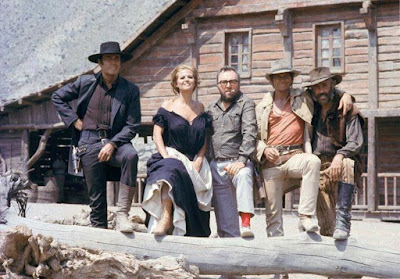directed by Gordon Douglas
screenplay Joseph Landon
book by Clair Huffaker
music by Jerry Goldsmith
There is no way Rio Conchos qualifies as a great Western, but there are enough interesting things about its story and cast to make it a good one. Director Gordon Douglas was a solid utility director who worked his way up through the Hal Roach studio, directing Our Gang shorts and Laurel and Hardy, and then seemingly whatever else came his way over the next forty years (including Them!). Its cast, led by Richard Boone of Have Gun - Will Travel, includes Stuart Whitman, Tony Franciosa, and, in his film debut, Jim Brown. Edmond O'Brien shows up late in the picture to chew up the scenery as a Confederate bitter-ender and Wende Wagner as an Apache woman named Sally.
The movie opens with a scene that seems to presage the soon to arrive revisionist and Spaghetti Westerns. An Apache burial party is ruthlessly gunned down by a lone white man, Lassister (Richard Boone). Most of them are shot in the back trying to get away. Apaches, we later learn, tortured and killed his family, and now he's carrying on a one-man race war against them. Soon after he's arrested by a cavalry troop led by Capt. Haven (Stuart Whitman) and accompanied by Sgt. Franklyn (Jim Brown). While it seems he's arrested for killing the Apaches, but Haven is interested in where Lassiter bought the repeating rifle he's carrying.
 |
| Richard Boone and Stuart Whitman |
It turns out the renegade Col. Pardee is arming the Apaches with repeating rifles he stole from the army. He's come to the conclusion that the Confederacy failed because it wasn't brutal enough during the war, so now he intends to persuade the Apaches to act as his proxies and raise bloody hell across the border region. From his base in Mexico - a recreation of a Southern plantation house out in the desert - Pardee and his coterie of fellow Confederate veterans are joyfully awaiting the day of their victory.
Capt. Haven's commander, Col. Wagner knows Lassister served under Pardee and convinces him to lead Haven and Franklyn to Pardee and hopefully destroy the cache of weapons. Lassister agrees, but only on the condition that he can be joined by Juan Louis Rodriguez (Franciosa), a prisoner of his acquaintance slated for execution.
 |
| Jim Brown and Tony Franciosa |
The four set out for Pardee's camp. Along the way, there are run-ins with banditos, a racist barkeep, and finally Apaches and Confederates. Save for the ending, there's nothing particularly surprising or original about Rio Conchos, except for the way it's played - which is with total seriousness. Oh, Franciosa plays Rodriguez with a bright twinkle in his eye, but it only disguises his character's ruthlessness. Everyone else comes at their role with deadly earnestness, especially Boone. Boone's voice never rises, never changes in affect, even when nearly beating a man to death it remains at the same cold, steely tone. This is the closest to playing the hero I've ever seen Boone (I haven't seen Have Gun - Will Travel yet), but he's no good guy. As Haven, Whitman is a martinet driven by his own failure to go after Pardee. Only Brown's Franklyn doesn't have a bad side, though he has to deal with casual racism from most of the white men he meets.
Rio Conchos isn't a revisionist Western - the very traditional-sounding Goldsmith score alone helps make it feel like a traditional one - but it's clearly walking on the road in that direction. There were Indian-murdering protagonists before 1964 - Ethan Hunt in The Searchers, most prominently - but Lassister is clearly a man obsessed beyond reason. Race, while not a huge factor in the movie, nonetheless isn't avoided. The simple presence of Brown at the height of his NFL career in the middle of the Civil Rights era had to have forced contemporary viewers to at least think about the situation of Sgt. Franklyn in post-Civil War America. Finally, unlike too many Westerns, there isn't any nostalgia for the Confederates. Pardee is a madman and his whole plan is to unleash an army of killers to duplicate the savagery inflicted on Lassiter across the whole American border region.
 |
| Edmond O'Brien |
Rio Conchos is visually adequate if never particularly memorable. It benefits greatly from being filmed in Moab, Utah. The mesa-filled landscape is so striking it overrides the non-descript cinematography. The action is well-shot and Douglas clearly had a sure hand depicting violence. The scenes aren't gory but they don't pull punches either. When men die it hurts.
I'm not sure how much remembered Rio Conchos is anymore. It never reaches the heights of The Searchers or the loopiness of A Fistful of Dollars, but, then it doesn't aim for those things. It's just a competently constructed and acted Western that'll take up 107 minutes of an evening. Also, anything starring Richard Boone is worth at least one viewing.
Rating - B: Again, just 107 minutes of adequate Western goodness. Nothing spectacular, but you won't feel like your time was wasted or your intelligence insulted
Rio Conchos' Historical Location
Rating System
A: Ace - Brilliant or groundbreaking; one of the best that no fan should miss.
B: Bravo - Good stuff, but less than perfection
C: Cowpoke - Routine oater, filler
D: Dismal - Sloppy or junky, but either way not worth the runtime










